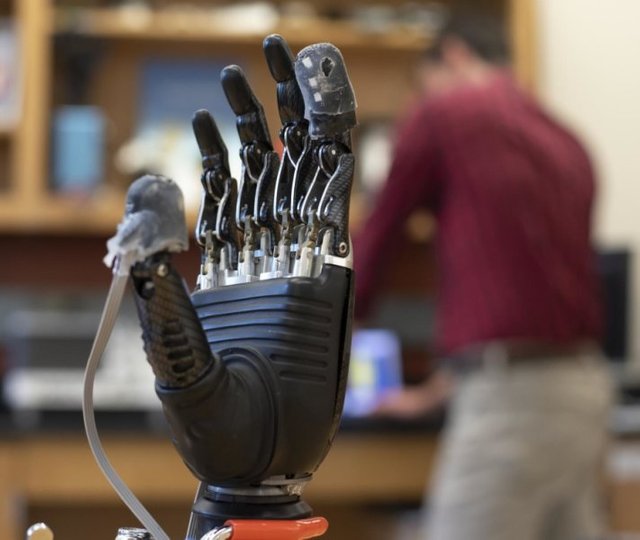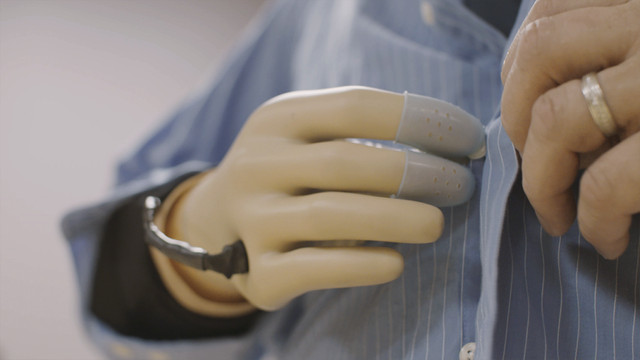Artificial skin allows you to feel pain

People with amputated limbs often experience so-called "sick ghosts", they feel that missing body parts still exist. This sense illusion can become a reality thanks to a team of researchers and engineers from Johns Hopkins University. They create an artificial electronic skin, which is placed in the prosthesis and returns to the person a sense of touch, as if he were touching something with the tip of his own fingers.
An anonymous volunteer with amputated arms is the ultimate test of the innovation system, scientists cite the words he says: "After all these years, I feel my hands again, as if the emptiness again becomes full of flesh."
Made of fabric and rubber, electronic skin "e-dermis" equipped with sensors to simulate nerve endings. It creates a sense of touch and even pain, registering stimuli and sending impulses to one's peripheral nervous system.
The results of this development were published on June 20 in the journal "Scientific Robotics", they show that it is currently possible to restore a number of natural sensory sensations in patients with amputated limbs if they use prosthetic limbs. The ability to feel pain can be useful, for example, with the possibility of damage to an artificial limb.
The developers say they create sensors that transmit signals from touch like real human skin. They take as basic only the natural physiological processes of the organism and create them for the prosthesis.
This is not a new device, not an artificial limb, but only shell covers for the prosthesis, which already has the patient and the one he is accustomed to. New functions added to it, the electronic skin can "tell" the owner how to touch the object yes.

Human skin contains a complex receptor network that sends various signals to the brain. This network has been the prototype of sensors, biological templates for the Robotics research group and bioengineers from Johns Hopkins University and the Singapore Institute of Neurotechnology.
Giving the modern prosthesis the function of human touch and registration of pain will enable the patient to live an ever more full life, slightly different than usual, with time the technology will evolve so that we can not understand that something is wrong with someone, it will look like us, Members of the body will even exceed our hands and feet in terms of function.
The pain, of course, is an unpleasant feeling, but it is also an important body protective system, which is not present in the prosthesis. With the use of amputations they have no significant feedback.
This is where it comes to electronic skin aids, sending impulses to peripheral nerves, thus creating "ghost" limbs. E-dermis does this by stimulating stubular nerves with electrical impulses in a non-invasive way, through the skin. Thus, the prosthesis can provide various perceptions, from weak to strong, destructive touch pressures, which make it very similar to the human hand - we can also feel touch or pain.

The electronic skin allows the user to feel a continuous spectrum of tactile perception. The team created a neuromorphic model that mimics the sensory receptors and pain of the human nervous system, the e-dermis encodes the electronic sensation signals as well as the receptors on our skin. Tracking brain activity through electroencephalography or EEG, the researchers determined that the subjects felt these signals as sensations from their own hands.
The noninvasive method of signal transmission is nerve stimulation through the skin, known in our literature as TENS-transcutaneous electrical nerve stimulation. During the experiment, the volunteers experience a natural reflexive reaction when touching a sharp object - pain and when touching a round object - without pain.
Electronic skin is not sensitive to temperature, in this research the emphasis is on determination of the relief object. In the future, nothing prevents the addition of sensors that will send painful pulses when dangerous hot objects are detected. The e-dermis technology can be used not only for patients with amputations, but also for robotic systems, to manipulate artificial limbs or in astronaut gloves.
American Johns Hopkins University in Baltimore is a recognized leader in the field of artificial limbs. They make the patient's life more comfortable and closer to the day when the cyborg becomes a reality.
Please upvote: https://steemit.com/free/@bible.com/4qcr2i